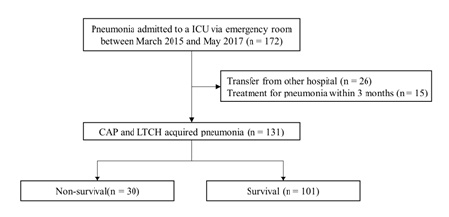Kosin Med J.
2019 Jun;34(1):15-23. 10.7180/kmj.2019.34.1.15.
Prognostic Value of Procalcitonin in Pneumonia among Patients Admitted to Intensive Care Unit.
- Affiliations
-
- 1Department of Pulmonology, Asan Choongmu Hospital, Asan, Korea.
- 2Department of Cardiology, Daegu Catholic University Medical Center, Daegu, Korea.
- 3Department of Internal Medicine, Inje University Ilsan Paik Hospital, Goyang, Korea. inspirit26@paik.ac.kr
- KMID: 2451771
- DOI: http://doi.org/10.7180/kmj.2019.34.1.15
Abstract
OBJECTIVES
Pneumonia is one of the leading causes of death in the intensive care unit (ICU). Many biomarkers for predicted prognosis have been suggested; among these, procalcitonin (PCT) is known to increase in cases of bacterial infection. However, there have been many debates regarding whether PCT is an appropriate prognostic marker for pneumonia. Therefore, we investigated whether PCT can serve as a biomarker for pneumonia, and compared it with CURB-65, which is a known tool for predicting the prognosis of pneumonia.
METHODS
Levels of PCT and CURB-65 scores were compared between 30-day non-survival (n = 30) and survival (n = 101) patients. Relationships between PCT and CURB-65 were determined by using linear regression analysis, as well as by using receiver operating characteristic (ROC) curve analysis and calculation of the area under the curve (AUC). High and low PCT groups were compared.
RESULTS
High PCT and high CURB-65 score were positively associated with 30-day mortality. For the prediction of 30-day mortality, initial PCT and CURB-65 exhibited AUCs of 0.63 and 0.66; these were not significantly different (P = 0.132). We found that the high PCT group had a higher rate of initial treatment failure (91%, P = 0.004).
CONCLUSIONS
Initial PCT can be a prognostic biomarker for mortality in severe pneumonia, similar to the CURB-65 score. Initial high PCT was positively associated with initial treatment failure.
Keyword
MeSH Terms
Figure
Reference
-
1. Xu J, Murphy SL, Kochanek KD, Bastian BA. Deaths: Final Data for 2013. Natl Vital Stat Rep. 2016; 64:1–119.2. Leu HS, Kaiser DL, Mori M, Woolson RF, Wenzel RP. Hospital-acquired pneumonia. Attributable mortality and morbidity. Am J Epidemiol. 1989; 129:1258–1267.3. Masterton RG, Galloway A, French G, Street M, Armstrong J, Brown E, et al. Guidelines for the management of hospital-acquired pneumonia in the UK: report of the working party on hospital-acquired pneumonia of the British Society for Antimicrobial Chemotherapy. J Antimicrob Chemother. 2008; 62:5–34.
Article4. Woodhead M, Blasi F, Ewig S, Garau J, Huchon G, Ieven M, et al. Guidelines for the management of adult lower respiratory tract infections--full version. Clin Microbiol Infect. 2011; 17:E1–E59.5. Hohenthal U, Hurme S, Helenius H, Heiro M, Meurman O, Nikoskelainen J, et al. Utility of C-reactive protein in assessing the disease severity and complications of community-acquired pneumonia. Clin Microbiol Infect. 2009; 15:1026–1032.
Article6. van Vugt SF, Broekhuizen BD, Lammens C, Zuithoff NP, de Jong PA, Coenen S, et al. Use of serum C reactive protein and procalcitonin concentrations in addition to symptoms and signs to predict pneumonia in patients presenting to primary care with acute cough: diagnostic study. BMJ. 2013; 346:f2450.
Article7. Pόvoa P, Coelho L, Almeida E, Fernandes A, Mealha R, Moreira P, et al. Early identification of intensive care unit-acquired infections with daily monitoring of C-reactive protein: a prospective observational study. Crit Care. 2006; 10:R63.8. Ramírez P, Ferrer M, Marti V, Reyes S, Martinez R, Menéndez R, et al. Inflammatory biomarkers and prediction for intensive care unit admission in severe community-acquired pneumonia. Crit Care Med. 2011; 39:2211–2217.
Article9. Jain S, Sinha S, Sharma SK, Samantaray JC, Aggrawal P, Vikram NK, et al. Procalcitonin as a prognostic marker for sepsis: a prospective observational study. BMC Res Notes. 2014; 7:458.
Article10. Assicot M, Gendrel D, Carsin H, Raymond J, Guilbaud J, Bohuon C. High serum procalcitonin concentrations in patients with sepsis and infection. Lancet. 1993; 341:515–518.
Article11. Horie M, Ugajin M, Suzuki M, Noguchi S, Tanaka W, Yoshihara H, et al. Diagnostic and prognostic value of procalcitonin in community-acquired pneumonia. Am J Med Sci. 2012; 343:30–35.
Article12. Menéndez R, Martínez R, Reyes S, Mensa J, Filella X, Marcos M, et al. Biomarkers improve mortality prediction by prognostic scales in community-acquired pneumonia. Thorax. 2009; 64:587–591.
Article13. Carratalà J, Fernández-Sabé N, Ortega L, Castellsagué X, Rosόn B, Dorca J, et al. Outpatient care compared with hospitalization for community-acquired pneumonia: a randomized trial in low-risk patients. Ann Intern Med. 2005; 142:165–172.
Article14. Walker HK. Clinical Methods: The History, Physical, and Laboratory Examinations. 3rd ed. Boston: Butterworths;1990.15. Maruyama T, Fujisawa T, Okuno M, Toyoshima H, Tsutsui K, Maeda H, et al. A new strategy for healthcare-associated pneumonia: a 2-year prospective multicenter cohort study using risk factors for multidrug-resistant pathogens to select initial empiric therapy. Clin Infect Dis. 2013; 57:1373–1383.
Article16. National Kidney Foundation. K/DOQI clinical practice guidelines for chronic kidney disease: Evaluation, classification, and stratification. Am J Kidney Dis. 2002; 39:S1–S266.17. Schuetz P, Suter-Widmer I, Chaudri A, Christ-Crain M, Zimmerli W, Mueller B, et al. Prognostic value of procalcitonin in community-acquired pneumonia. Eur Respir J. 2011; 37:384–392.
Article18. Liu D, Su LX, Guan W, Xiao K, Xie LX. Prognostic value of procalcitonin in pneumonia: A systematic review and meta-analysis. Respirology. 2016; 21:280–288.
Article19. James MT, Quan H, Tonelli M, Manns BJ, Faris P, Laupland KB, et al. CKD and risk of hospitalization and death with pneumonia. Am J Kidney Dis. 2009; 54:24–32.
Article20. Guo SY, Zhou Y, Hu QF, Yao J, Wang H. Procalcitonin is a marker of gram-negative bacteremia in patients with sepsis. Am J Med Sci. 2015; 349:499–504.
Article
- Full Text Links
- Actions
-
Cited
- CITED
-
- Close
- Share
- Similar articles
-
- Usefulness of Semi-quantitative Procalcitonin Assay in Critically Ill Patients with Bacterial Pneumonia
- The prognostic value of procalcitonin, C-reactive protein and cholesterol in patients with an infection and multiple organ dysfunction
- Cardiac Complications in Patients Admitted to the Neuro-Intensive Care Unit
- Semi-quantitative Procalcitonin Assay in Critically ill Patients with Respiratory infections
- The Characteristics and Prognostic Factors of Severe Sepsis in Patients Who Were Admitted to a Medical Intensive Care Unit of a Tertiary Hospital



